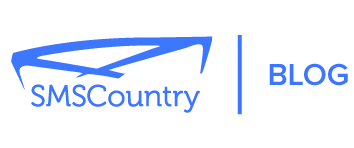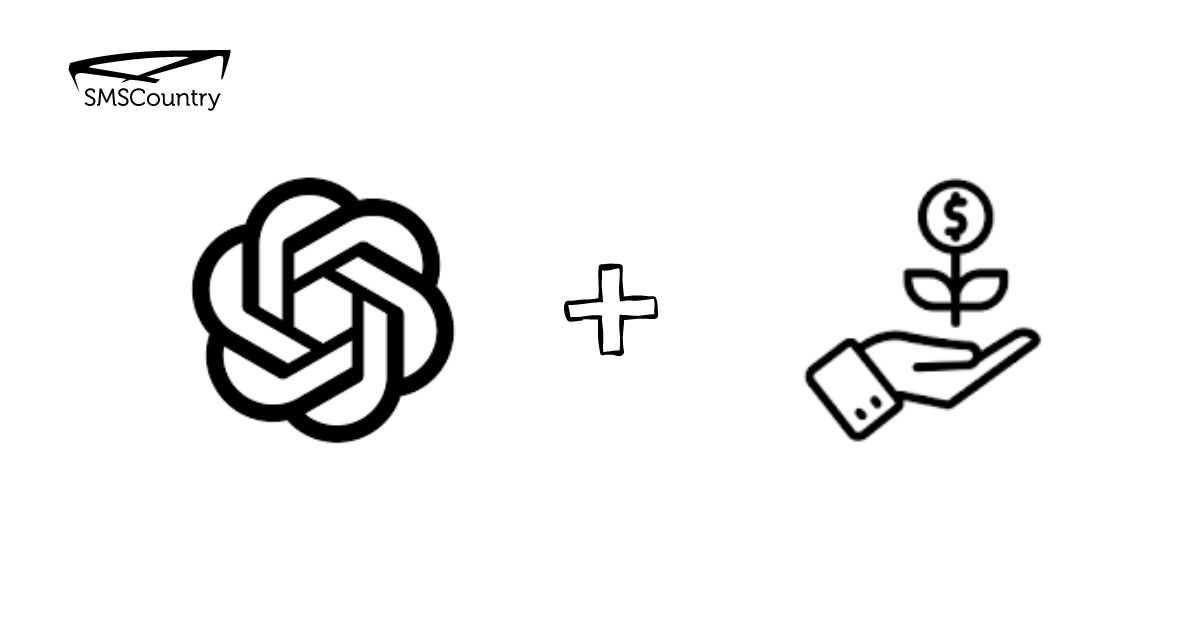Do you feel like a hamster running on a wheel while developing a product?
Do you wish you had a magic wand to make the process easier?
Well, we can’t give you a wand.
But we can tell you about the next best thing – artificial intelligence (AI) and ChatGPT.
These tools can enhance product and business development by making it better and faster.
In this article, we’ll show you how to use these tools to your advantage.
Ready to kiss your product and business development problems goodbye?
Then, let’s begin with understanding all about AI.
Note: In this article, we use product and business together or interchangeably.
| SMSCountry is the best bulk SMS service to delight your customers. Learn more about our SMS services. Get started or schedule a demo. |
What is AI?
Think of all the sci-fi movies where robots take over the world.
That’s AI – but without the world domination part (hopefully).
AI is the ability of computer programs to perform tasks that require human intelligence. AI is like little digital minions programmed to do your bidding.
AI can understand language, recognise images, and make decisions.
Wondering how AI does its magic?
AI uses fancy algorithms and statistical models to understand data and make predictions.
Think of it like a digital crystal ball. But instead of predicting the future, it predicts what products people will like.
Virtual assistants such as Siri or Alexa are great examples of AI already in action. They use AI to understand and respond to user requests.
Speaking of AI examples, how can we not mention the latest addition – ChatGPT?
What is ChatGPT?

Ever heard of the old legend of the genie? One that grants three wishes to whoever rubs the magic lamp it lives in?
Well, ChatGPT is similar.
Except instead of a genie, it’s a computer program.
ChatGPT is a language model developed by OpenAI. It generates human-like responses to text prompts.
It’s like your digital writing buddy who comes up with clever ideas in an instant.
But here’s the big question.
How can ChatGPT enhance the process of product and business development for you?
It can provide automated responses to common queries.
It also helps generate text prompts.
And the coolest part?
While your genie grants three wishes, ChatGPT is always at your beck and call.
What is product development?
Business and product development is like preparing a delicious meal.
First, you create an exact recipe in mind.
Next, you gather all the necessary ingredients for the recipe.
Then, you follow the steps in the correct order.
That’s how you create a tasty and satisfying dish.
Product and business development is similar. It’s the process of creating a new product from start to finish.
Just like preparing a meal, product and business development requires careful planning.
Attention to detail is vital.
First, you identify the market needs and brainstorm ideas for your product.
Next, you design, test, and refine the product.
Then, you can finally launch the product to the public.
This process applies to any type of product development. This can include a physical product like a kitchen gadget to a digital product like an online course or mobile app.
The entire process can get easy if you use AI and ChatGPT.
What do AI and ChatGPT have to do with product development?

Imagine you’re a chef. And you’re trying to create a new dish for your restaurant.
You have all the ingredients.
But you’re unsure how to assemble them for a new delicious meal.
Now, that’s where AI and ChatGPT come in.
First, AI analyses customer feedback and preferences. This helps you know what flavours and ingredients are most popular.
ChatGPT can suggest new and creative ways to combine these ingredients.
Then, you can create a unique dish that will have your customers raving.
How do you use AI to speed up your business and product development process?
AI and ChatGPT work in similar ways to help you with product development.
They’re like your sous chef and brainstorming partners all in one (without the attitude or the expensive salary).
You only need to utilise AI-powered shortcuts and commands to make product development a breeze. These commands are known as prompts.
You develop a product in four phases. AI can help you ace each phase. Here’s how.
Phase 1: Product ideation and concept development

Most of us find brainstorming for ideas a daunting task. But you no longer need to feel stressed about generating ideas.
AI can solve this problem for you. AI generates ideas based on your prompts. You save both time and brainpower.
AI chatbots can also help you refine those ideas. They give you feedback on what will work best.
All you need is the best tool for product ideation and concept development.
Top AI tools for product ideation and concept development
Here are three top AI tools you can use for product ideation and concept development:
- Ideanote: This AI tool lets you capture and organise your ideas. With Ideanote, you can also collaborate with your team to refine these ideas. Ideanote’s pricing starts at $89/month.
- OpenAI’s GPT-3: GPT-3 is an AI language model that helps you generate human-like language. It can create descriptions, product names, and marketing copy. GPT-3 plans include a free one.
- Canva: Canva uses AI algorithms to suggest design elements, layouts, and colours for your product design. It also provides access to a vast library of design templates and graphics. Canva has free and paid plans starting at $12.95/month.
You can use these AI tools to generate ideas for a new product. You’ll also speed up and improve the process of your product development.
Phase 2: Product design and development

Next comes a crucial phase of product development – product design and development.
This is when you take your idea from the drawing board to the laboratory. You give your idea flesh and bones. You transform it into a tangible thing that customers can use.
Below is a step-by-step guide to using AI during the product design and development phase:
- Identify the design problem: Before using the AI tool, you must clearly understand the design problem you wish to solve. Identify the key features and requirements of your product. Highlight any constraints you may face.
- Collect and analyse data: AI relies on data to learn and make predictions. Hence, you must collect and analyse relevant data for using AI. This includes customer feedback, market research, and data from previous product iterations.
- Pick an AI tool: Some AI tools are 3D modelling software, while others are virtual assistants. Choose an AI tool that aligns with your specific design problem and needs.
- Integrate the tool: Integrate your chosen AI tool into your design process. One way is to use an AI-powered algorithm to generate design options. You can also use a virtual assistant to streamline your workflow.
- Evaluate and refine: Evaluate the AI tool’s effectiveness after implementing it into your design process. This includes gathering user feedback or adjusting your data collection and analysis methods. Refine your approach based on your evaluation.
Remember to pick the right AI tool to accelerate your product design and development process.
Top AI tools for product design and development
These top AI tools can make your product design and development phase a breeze:
- 3D modelling: Autodesk Fusion 360 and SketchUp help you create 3D models of your product designs. Fusion 360 starts at $60/month, and SketchUp Pro starts at $299.
- Simulation: SimScale and ANSYS let you test your product’s performance under different conditions. They can help you optimise your design for maximum results. SimScale and ANSYS offer flexible pricing plans based on usage.
- Virtual prototyping: No need to spend time and money on physical prototypes. Use Proto.io and InVision to create interactive prototypes that look and feel real. You can get feedback from stakeholders and customers early on and make changes.
The best part about these AI-powered tools is that they won’t break the bank.
| See how SMSCountry helped Gaurav fix the OTP issues he had using Twilio and Alibaba. Read his story of disappointment with Twilio and how SMSCountry SMS API saved the day. |
Phase 3: Product testing and optimisation

You came up with a fantastic product idea. Next, you designed it.
So now, it’s time to put it to the test. And this is where AI comes in once again as your rescue.
AI can help you optimise your product for success.
Here’s how:
- A/B testing: You can check which version of your product performs better. This includes pricing strategies and product features. You can see which versions drive the most sales.
- User feedback analysis: You can extract valuable insights from customer reviews, comments, and social media posts. This will help you identify common issues, address customer pain points, and improve your product before launch.
- Predictive analytics: Finally, you use AI-powered predictive analytics to forecast your product’s performance in the market. AI tools can also help you predict sales volumes, customer demand, and potential roadblocks.
You need AI-powered tools in your arsenal to optimise your product for success.
Top AI tools for product testing and optimisation
Below are the top 3 AI tools you can use for product testing and optimisation:
- Apptimize: This tool helps you run A/B tests, rollouts, and feature flagging. Its pricing starts at $300 per month.
- Testim.io: This AI-based testing tool helps you automate end-to-end testing. Its pricing starts at $500 per month.
- Optimizely: This one’s popular for A/B testing, personalisation, and experimentation. Its pricing starts at $999 per month.
These tools also let you test various features of your products and ensure they work as intended.
Once you are happy with your final product, you’re ready to move to the final phase.
Phase 4. Launch and post-launch monitoring

Your product’s launch is like a rocket launch. The process includes many moving parts. So you need to ensure that everything works perfectly.
NASA uses AI to monitor their spacecraft post-launch. Likewise, you can use AI to monitor your product launch and post-launch activities.
In this phase of product development, you can use AI to do the following:
- Monitor social media: Use AI tools to see how people react to your product launch. AI can track mentions, sentiments, and engagements.
- Provide customer support: Use AI-powered chatbots for customer support during and after your product launch. AI chatbots can handle common questions and issues.
- Forecast sales: AI algorithms can analyse past sales data. This can help you make informed decisions about inventory and marketing.
AI also helps you catch issues early and respond quickly to customer needs.
Find all the SMS templates you need here –> Free SMS Templates
You can also make data-driven decisions to optimise your product’s success.
There are specific AI AI-powered tools you can use for this phase.
Top AI tools for product launch and post-launch monitoring
Below are the 3 top AI tools for product launch and post-launch monitoring:
- Google Analytics: This free tool tracks website traffic and user behaviour. The premium features, which come under Google Analytics 360, require a subscription.
- Hootsuite Insights: This monitors your social media conversations and tracks sentiments around your product. Pricing for Hootsuite Insights starts at $29 per month.
- Salesforce Marketing Cloud: Track your customer interactions across multiple channels, including email, social media, and mobile apps. Pricing for Salesforce Marketing Cloud varies depending on the features and support needed.
All these AI tools offer valuable insights for product launch and post-launch monitoring.
ChatGPT can further take your product launch and monitoring to the next level. With advanced natural language processing, ChatGPT engages users, collects feedback, and refines your product.
Let’s see how you can effectively harness ChatGPT in your business and product development journey.
How do you use ChatGPT for business and product development?
ChatGPT is your business and product development buddy. It gives you the power of AI at your fingertips.
You can turn to ChatGPT for everything – from idea generation to post-launch monitoring.
How?
These use cases will show you how this amazing AI tool can help you bring your products to life.
Use case 1: Idea generation

You know that feeling when you’re thinking about a new product concept, but your brain gets stuck in neutral?
Well, ChatGPT is here to help kickstart your creativity.
How?
Simply type in some prompt related to your product or industry.
Then, watch ChatGPT do the heavy lifting.
This little chatterbox generates wild and wacky ideas you would never have thought of alone.
You might even unlock your next big hit with ChatGPT’s help.
Use case 2: Market research

Okay, so you’ve got a product idea that you’re excited about.
But how do you know if there’s a demand for it in the market?
That’s where ChatGPT comes in again.
It can analyse your customer data and social media trends.
So, you can use ChatGPT to gauge your product’s demand and to identify potential market gaps.
ChatGPT will help you make data-driven decisions and ensure you’re not just flying blind.
Use case 3: Design feedback

So you’ve got a prototype of your product.
You feel so good about it.
But, before you take it to market, pause.
You must ensure the design is as polished as possible.
ChatGPT can act as your design consultant here.
It analyses visual data and provides feedback even on colour schemes and font choices.
ChatGPT even generates ideas for alternate designs that you might not have considered.
Isn’t that amazing?
Plus, ChatGPT never gets tired or cranky. You can request feedback as many times as you need to.
Use case 4: Quality control

You’ve launched your product, and it’s now in the market.
But how do you know it’s living up to your quality standards?
ChatGPT can help with that, too.
This AI tool analyses your customer feedback and product reviews. You can identify any areas where your product might fall short.
It can even generate suggestions for improving quality or fixing any issues customers are experiencing.
You can feel confident that your product meets your customers’ expectations. But hold on; you also need ChatGPT post-launch.
Use case 5: Post-launch monitoring

Imagine your product is a hit.
But you can’t rest on your laurels just yet.
There’s still some work pending.
You must keep your product at the top of its game.
And there comes your genie once again: ChatGPT.
ChatGPT can help you monitor the market and stay ahead of the competition.
This genie can identify opportunities for new features or enhancements in your product.
It can also help you stay on top of negative reviews or customer complaints. This way, you can address them quickly and keep your customers happy.
50 proven ChatGPT prompts for product development that you can use today
Here are some real prompts for using ChatGPT in product and business development: These ChatGPT prompts are for website development, website development, product managers, marketers, entrepreneurs, business owners and developers, erc.
- “Generate product name ideas for a new tech gadget.”
- “Suggest features to improve user experience on a mobile app.”
- “Provide insights on how to improve website conversion rates.”
- “Generate ideas for a new product line in the beauty industry.”
- “Suggest strategies to increase customer retention for an e-commerce website.”
- “Provide feedback on a new product packaging design.”
- “Generate ideas for a new feature on a fitness tracking app.”
- “Suggest ways to reduce manufacturing costs for a hardware product.”
- “Provide insights on how to improve the onboarding process for a SaaS product.”
- “Generate ideas for a marketing campaign for a new food product.”
- “Suggest ways to improve the user interface of a social media platform.”
- “Provide feedback on a new logo design for a fashion brand.”
- “Generate ideas for a new product to add to a subscription box service.”
- “Suggest strategies to increase customer engagement for an online education platform.”
- “Provide insights on how to improve the user experience of a virtual event platform.”
- “Generate ideas for a new feature on a financial management app.”
- “Suggest ways to reduce shipping times for an e-commerce store.”
- “Provide feedback on a new product design for a furniture company.”
- “Generate ideas for a new product line in the pet industry.”
- “Suggest ways to improve the user interface of a booking website.”
- “Provide insights on how to improve the checkout process for an online store.”
- “Generate ideas for a new feature on a music streaming app.”
- “Suggest strategies to increase brand awareness for a startup company.”
- “Provide feedback on a new product video for a tech gadget.”
- “Generate ideas for a new product to add to a home decor store.”
- “Suggest ways to improve the search functionality of an e-commerce website.”
- “Provide insights on how to improve the customer service experience for a telecommunications company.”
- “Generate ideas for a new feature on a gaming app.”
- “Suggest strategies to increase user engagement for a video-sharing platform.”
- “Provide feedback on a new product tagline for a health supplement.”
- “Generate ideas for a new product line in the baby industry.”
- “Suggest ways to improve the user interface of a news website.”
- “Provide insights on how to improve the email marketing campaign for a software company.”
- “Generate ideas for a new feature on a travel booking app.”
- “Suggest strategies to increase sales for a fashion retailer.”
- “Provide feedback on a new product packaging design for a snack brand.”
- “Generate ideas for a new product to add to a luxury goods store.”
- “Suggest ways to improve the checkout process for a subscription-based service.”
- “Provide insights on how to improve the user experience of a job search website.”
- “Generate ideas for a new feature on a language-learning app.”
- “Suggest strategies to increase user retention for a social networking platform.”
- “Provide feedback on a new product tagline for a beverage brand.”
- “Generate ideas for a new product line in the outdoor recreation industry.”
- “Suggest ways to improve the user interface of a recipe website.”
- “Provide insights on how to improve the customer service experience for a financial institution.”
- “Generate ideas for a new feature on a meditation app.”
- “Suggest strategies to increase user engagement for an e-learning platform.”
- “Provide feedback
- “Generate ideas for a new feature for our product.”
- “What are some potential roadblocks we may face during the product development process?”
- “Can you provide suggestions for improving our product’s user interface?”
You can use these prompts on ChatGPT in various stages of product and business development.
Skyrocket your business and product development
You now know how to use ChatGPT for each stage of product development.
But why stop there?
From ideation to post-launch monitoring, ChatGPT can always help you. You can generate innovative ideas and optimise your product.
But with SMSCountry’s API, you can take your product messaging to a new level.
SMSCountry’s text, WhatsApp, and voice solutions let you communicate with your customers, from OTP to other updates. You can also gather their feedback with ease and improve your product’s performance.
Schedule a free demo or sign up for free today to see how we can help you with your product.





